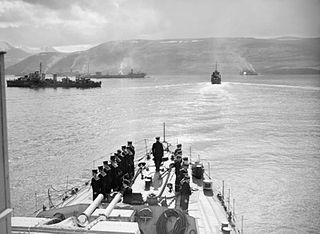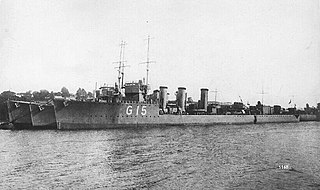
Convoy PQ 17 was an Allied Arctic convoy during the Second World War. On 27 June 1942, the ships sailed from Hvalfjörður, Iceland, for the port of Arkhangelsk in the Soviet Union. The convoy was located by German forces on 1 July, shadowed and attacked.

HMS Arab was a B-class torpedo boat destroyer of the British Royal Navy. She was laid down by J & G Thomson at Clydebank and completed by John Brown & Company who took over the yard.

The Second Battle of Heligoland Bight, also the Action in the Helgoland Bight and the Zweite Seeschlacht bei Helgoland, was an inconclusive naval engagement fought between British and German squadrons on 17 November 1917 during the First World War.
Nine ships of the Royal Navy have been named Mary Rose. The first is thought to have been named after Mary Tudor, sister of King Henry VIII of England, and the rose, the symbol of the Tudor dynasty. Later Mary Roses are named after the first.

HMS Electra was a one of nine E-class destroyers built for the Royal Navy during the 1930s. Sunk in the Battle of the Java Sea, Electra was a witness to many naval battles, including the Battle of the Denmark Strait and the sinking of Prince of Wales and Repulse. The ship's wreck was discovered in 2003 and had been badly damaged by illegal salvagers by 2016.

Convoy PQ 18 was an Arctic convoy of forty Allied freighters from Scotland and Iceland to Arkhangelsk in the Soviet Union during the Second World War. The convoy departed Loch Ewe, Scotland on 2 September 1942, rendezvoused with more ships and escorts at Iceland and arrived at Arkhangelsk on 21 September. An exceptionally large number of escorts were provided by the Royal Navy in Operation EV, including the first escort carrier to accompany an Arctic convoy. Detailed information on German intentions was provided by the code breakers at Bletchley Park and elsewhere, through Ultra signals decrypts and eavesdropping on Luftwaffe wireless communications.

HMS Nigeria was a Fiji-class light cruiser of the Royal Navy completed early in World War II and served during that conflict. She was named after the British colony of Nigeria.

The Brummer class consisted of two light mine-laying cruisers built for the Imperial German Navy in World War I: SMS Brummer and SMS Bremse. When the war broke out, the Germans had only two older mine-laying cruisers. Although most German cruisers were fitted for mine-laying, a need for fast specialized ships existed. The Imperial Russian Navy had ordered sets of steam turbines for the first two ships of the Svetlana-class cruisers from the AG Vulcan shipyard in Stettin. This machinery was confiscated on the outbreak of war and used for these ships. Both vessels were built by AG Vulcan.

SMS Brummer was a minelaying light cruiser of the German Kaiserliche Marine; she was the lead ship of her class. Her sister ship was Bremse. Brummer was laid down at AG Vulcan's shipyard in Stettin, Germany on 24 April 1915 and launched on 11 December 1915 and completed on 2 April 1916. Armed with a main battery of four 15-centimeter (5.9 in) guns in single mounts, she carried 400 mines.

SMS Bremse was a Brummer-class minelaying light cruiser of the German Kaiserliche Marine. She was laid down by AG Vulcan Stettin on 27 April 1915 and launched on 11 March 1916 at Stettin, Germany, the second of the two-ship class after her sister, SMS Brummer. She served during the First World War, operating most of the time in company with her sister. The two ships took part in an ambush on a convoy in the North Sea, where they sank two destroyers in a surprise attack, before hunting down and sinking nine merchantmen, after which they returned to port unscathed.

The action of 29 February 1916 was a naval engagement fought during the First World War between the United Kingdom and the German Empire. SMS Greif, a German commerce raider, broke out into the North Sea and Admiral Sir John Jellicoe dispatched Royal Navy warships to intercept the raider. Four British vessels intercepted the commerce raider Greif. The armed merchant cruiser RMS Alcantara and Greif fought a brief engagement before British reinforcements arrived when both were severely damaged, both being sunk.

The action off Lerwick was a naval engagement on 17 October 1917 fought in the North Sea during the First World War. The German light, minelaying cruisers SMS Brummer and Bremse attacked a westbound convoy of twelve colliers and other merchant ships and their escorts, part of the regular Scandinavian convoy. The two escorting destroyers and nine neutral Scandinavian ships were sunk off Shetland, Scotland.

HMS Strongbow was an M-class destroyer built for the British Royal Navy during the First World War. The ship was launched in September 1916 and entered service in November that year. Stongbow was sunk on 17 October 1917 by the German light cruisers SMS Bremse and Brummer in the North Sea, when escorting a convoy of merchant ships from Norway.

The Italian torpedo boat Lupo was a Spica-class torpedo boat built for the Regia Marina in the late 1930s. During the Second World War, Lupo was involved in several naval actions, including that of the eponymous "Lupo convoy", for which she was awarded the Silver Medal of Military Valour. Lupo was sunk in action on 2 December 1942.

HMS Partridge was a Royal Navy Admiralty M-class destroyer constructed and then operational in the First World War, later being sunk by enemy action in 1917. The destroyer was the sixth Royal Navy vessel to carry the name HMS Partridge.

HMS Rigorous was an R-class destroyer which served with the Royal Navy during World War I. Launched on 30 September 1916, the vessel operated as part of the Grand Fleet, operating as part of destroyer flotillas hunting German ships that were attacking convoys. One flotilla was successful in destroying a Q ship in 1917. After the War, the destroyer was given a reduced complement and was sold to be broken up on 5 November 1926.

The action of 11–12 December 1917 was a German naval operation in the North Sea against convoys sailing on the Scandinavian convoy route from Norway to Lerwick in the Shetland Islands during the First World War. Ships carrying coal from the loading port of Immingham on the Humber estuary were convoyed to Lerwick up the war channel, along the east coast of Northern England and Scotland, for dispatch in convoys to Scandinavian neutrals, along with ships carrying general cargo.

HMS Pellew was a Admiralty M-class destroyer which served with the Royal Navy during the First World War. The M class were an improvement on the preceding L class, capable of higher speed. Launched on 18 April 1916, the vessel served with the Grand Fleet escorting convoys. The vessel was part of an unsuccessful attempt by the navy to trap the German submarines that had taken such a heavy toll on merchant shipping in December 1917. The action involved an eight-ship convoy consisting of four merchant vessels escorted by two armed trawlers and the sister ships Pellew and Partridge. Instead of submarines, four German destroyers attacked, sinking all but one member of the convoy and disappearing before the light cruisers which were to be the spring in the trap could arrive. Pellew, the sole survivor, took refuge in a Norwegian fjord. After the armistice that ended the war, the destroyer was placed in reserve and subsequently sold to be broken up on 9 May 1921.

HMS Peregrine was a Admiralty M-class destroyer that served with the Royal Navy during the First World War. The M class were an improvement on the preceding L class, capable of higher speed. Launched on 29 May 1916, the vessel served with the Grand Fleet, focusing on anti-submarine warfare. In 1917, the destroyer was involved in the search for UC-65 after the submarine had sunk the protected cruiser Ariadne. In 1918, the ship participated in one of the final sorties of the war, although this did not lead to a confrontation with the German High Seas Fleet. After the Armistice that ended the war, the destroyer was placed in reserve and subsequently sold to be broken up on 9 May 1921.














